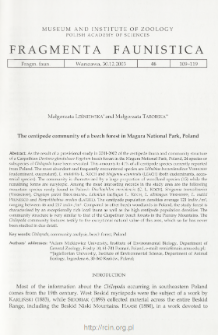- Wyszukaj w całym Repozytorium
- Piśmiennictwo i mapy
- Archeologia
- Baza Młynów
- Nauki przyrodnicze
Wyszukiwanie zaawansowane
Wyszukiwanie zaawansowane
Wyszukiwanie zaawansowane
Wyszukiwanie zaawansowane
Wyszukiwanie zaawansowane

Obiekt
Tytuł: The centipede community of a beech forest in Magura National Park, Poland
Twórca:
Leśniewska, Małgorzata ; Taborska, Małgorzata (biolog) ; Polska Akademia Nauk. Muzeum i Instytut Zoologii
Data wydania/powstania:
Typ zasobu:
Inny tytuł:
Fragmenta Faunistica, vol. 46, no. 2 ; Chilopoda of a beech forest in Magura N. P. ; Zgrupowanie pareczników lasu bukowego w Magurskim Parku Narodowym, Polska
Wydawca:
Museum and Institute of Zoology, PAS
Miejsce wydania:
Opis:
Bibliogr. s. 118-119 ; S. 109-119 : il. ; 25 cm ; Streszcz. pol. Nazwy taksonów również łac.
Typ obiektu:
Abstrakt:
As the result of a provisional study in 2001-2002 of the centipede fauna and community structure of a Carpathian Dentario glandulosae-Fagetum beech forest in the Magura National Park, Poland, 24 species or subspecies of Chilopoda have been revealed. This amounts to 41% of all centipede species currently reported from Poland. The most abundant and frequently encountered species are Lithobius burzenlandicus VERHOEFF (eudominant, euconstant), L. mutabilisL.KOCH and Strigamia acuminata (LEACH) (both eudominants, acces-sorial species). The community is characterised by a large proportion of woodland species (15) while the remaining forms are eurytopic. Among the most interesting records in the study area are the following mountain species rarely found in Poland: Dicellophilus carniolensis (C.L.KOCH), Strigamia transsilvanica (VERHOEFF), Cryptops parisi BROLEMANN, Lithobius lucifugus L.KOCH, L. silvivagus VERHOEFF, L. matici PRUNESCO and Harpolithobius anodus (LATZEL). The centipede population densities average 121 indiv./m2, ranging between 46 and 217 indiv./m2. Compared to other beech woodlands in Poland, the study forest is characterised by an exceptionally rich local faunaas well as the high centipede population densities. The community structure is very similar to that of the Carpathian beech forests in the Pieniny Mountains. The Chilopoda community features testify to the exceptional natural value of this area, which so far has never been studied in due detail.
Czasopismo/Seria/cykl:
Tom:
Zeszyt:
Strona pocz.:
Strona końc.:
Szczegółowy typ zasobu:
Format:
Identyfikator zasobu:
oai:rcin.org.pl:54522 ; 10.3161/00159301FF2003.46.2.109
Źródło:
MiIZ PAN, sygn. patrz sygn. czas. P.256, T. 46, nr 2 ; MiIZ PAN, sygn. patrz sygn. czas. P.4664, T. 46, nr 2 ; kliknij tutaj, żeby przejść
Język:
Prawa:
Licencja Creative Commons Uznanie autorstwa 3.0 Polska
Zasady wykorzystania:
Zasób chroniony prawem autorskim. [CC BY 3.0 PL] Korzystanie dozwolone zgodnie z licencją Creative Commons Uznanie autorstwa 3.0 Polska, której pełne postanowienia dostępne są pod adresem: ; -
Digitalizacja:
Muzeum i Instytut Zoologii Polskiej Akademii Nauk
Lokalizacja oryginału:
Biblioteka Muzeum i Instytutu Zoologii PAN
Dofinansowane ze środków:
Program Operacyjny Innowacyjna Gospodarka, lata 2010-2014, Priorytet 2. Infrastruktura strefy B + R ; Unia Europejska. Europejski Fundusz Rozwoju Regionalnego
Dostęp:
Kolekcje, do których przypisany jest obiekt:
- Repozytorium Cyfrowe Instytutów Naukowych > Kolekcje Partnerów > Muzeum i Instytut Zoologii PAN > Czasopisma
- Repozytorium Cyfrowe Instytutów Naukowych > Kolekcje Partnerów > Muzeum i Instytut Zoologii PAN > Wydawnictwa MiIZ PAN > Fragmenta Faunistica
- Repozytorium Cyfrowe Instytutów Naukowych > Piśmiennictwo > Czasopisma/Artykuły
Data ostatniej modyfikacji:
2 sie 2024
Data dodania obiektu:
24 cze 2015
Liczba pobrań / odtworzeń:
805
Wszystkie dostępne wersje tego obiektu:
https://rcin.org.pl./publication/61146
Wyświetl opis w formacie RDF:
Wyświetl opis w formacie RDFa:
Wyświetl opis w formacie OAI-PMH:
Obiekty Podobne
Leśniewska, Małgorzata Polska Akademia Nauk. Muzeum i Instytut Zoologii
Wytwer, Jolanta Polska Akademia Nauk. Muzeum i Instytut Zoologii International Congress of Myriapodology (11 ; 1999 ; Białowieża)
Leśniewska, Małgorzata Polska Akademia Nauk. Muzeum i Instytut Zoologii International Congress of Myriapodology (11 ; 1999 ; Białowieża)
Wirkner, Christian S. Pass, Günther Polska Akademia Nauk. Muzeum i Instytut Zoologii International Congress of Myriapodology (11 ; 1999 ; Białowieża)
Chagas Júnior, Amazonas (1972– ) Polska Akademia Nauk. Muzeum i Instytut Zoologii International Congress of Myriapodology (11 ; 1999 ; Białowieża)
Grońska, Jolanta
Tracz, Henryk Polska Akademia Nauk. Muzeum i Instytut Zoologii International Congress of Myriapodology (11 ; 1999 ; Białowieża)

 INSTYTUT ARCHEOLOGII I ETNOLOGII POLSKIEJ AKADEMII NAUK
INSTYTUT ARCHEOLOGII I ETNOLOGII POLSKIEJ AKADEMII NAUK
 INSTYTUT BADAŃ LITERACKICH POLSKIEJ AKADEMII NAUK
INSTYTUT BADAŃ LITERACKICH POLSKIEJ AKADEMII NAUK
 INSTYTUT BADAWCZY LEŚNICTWA
INSTYTUT BADAWCZY LEŚNICTWA
 INSTYTUT BIOLOGII DOŚWIADCZALNEJ IM. MARCELEGO NENCKIEGO POLSKIEJ AKADEMII NAUK
INSTYTUT BIOLOGII DOŚWIADCZALNEJ IM. MARCELEGO NENCKIEGO POLSKIEJ AKADEMII NAUK
 INSTYTUT BIOLOGII SSAKÓW POLSKIEJ AKADEMII NAUK
INSTYTUT BIOLOGII SSAKÓW POLSKIEJ AKADEMII NAUK
 INSTYTUT CHEMII FIZYCZNEJ PAN
INSTYTUT CHEMII FIZYCZNEJ PAN
 INSTYTUT CHEMII ORGANICZNEJ PAN
INSTYTUT CHEMII ORGANICZNEJ PAN
 INSTYTUT FILOZOFII I SOCJOLOGII PAN
INSTYTUT FILOZOFII I SOCJOLOGII PAN
 INSTYTUT GEOGRAFII I PRZESTRZENNEGO ZAGOSPODAROWANIA PAN
INSTYTUT GEOGRAFII I PRZESTRZENNEGO ZAGOSPODAROWANIA PAN
 INSTYTUT HISTORII im. TADEUSZA MANTEUFFLA POLSKIEJ AKADEMII NAUK
INSTYTUT HISTORII im. TADEUSZA MANTEUFFLA POLSKIEJ AKADEMII NAUK
 INSTYTUT JĘZYKA POLSKIEGO POLSKIEJ AKADEMII NAUK
INSTYTUT JĘZYKA POLSKIEGO POLSKIEJ AKADEMII NAUK
 INSTYTUT MATEMATYCZNY PAN
INSTYTUT MATEMATYCZNY PAN
 INSTYTUT MEDYCYNY DOŚWIADCZALNEJ I KLINICZNEJ IM.MIROSŁAWA MOSSAKOWSKIEGO POLSKIEJ AKADEMII NAUK
INSTYTUT MEDYCYNY DOŚWIADCZALNEJ I KLINICZNEJ IM.MIROSŁAWA MOSSAKOWSKIEGO POLSKIEJ AKADEMII NAUK
 INSTYTUT PODSTAWOWYCH PROBLEMÓW TECHNIKI PAN
INSTYTUT PODSTAWOWYCH PROBLEMÓW TECHNIKI PAN
 INSTYTUT SLAWISTYKI PAN
INSTYTUT SLAWISTYKI PAN
 SIEĆ BADAWCZA ŁUKASIEWICZ - INSTYTUT TECHNOLOGII MATERIAŁÓW ELEKTRONICZNYCH
SIEĆ BADAWCZA ŁUKASIEWICZ - INSTYTUT TECHNOLOGII MATERIAŁÓW ELEKTRONICZNYCH
 MUZEUM I INSTYTUT ZOOLOGII POLSKIEJ AKADEMII NAUK
MUZEUM I INSTYTUT ZOOLOGII POLSKIEJ AKADEMII NAUK
 INSTYTUT BADAŃ SYSTEMOWYCH PAN
INSTYTUT BADAŃ SYSTEMOWYCH PAN
 INSTYTUT BOTANIKI IM. WŁADYSŁAWA SZAFERA POLSKIEJ AKADEMII NAUK
INSTYTUT BOTANIKI IM. WŁADYSŁAWA SZAFERA POLSKIEJ AKADEMII NAUK


































